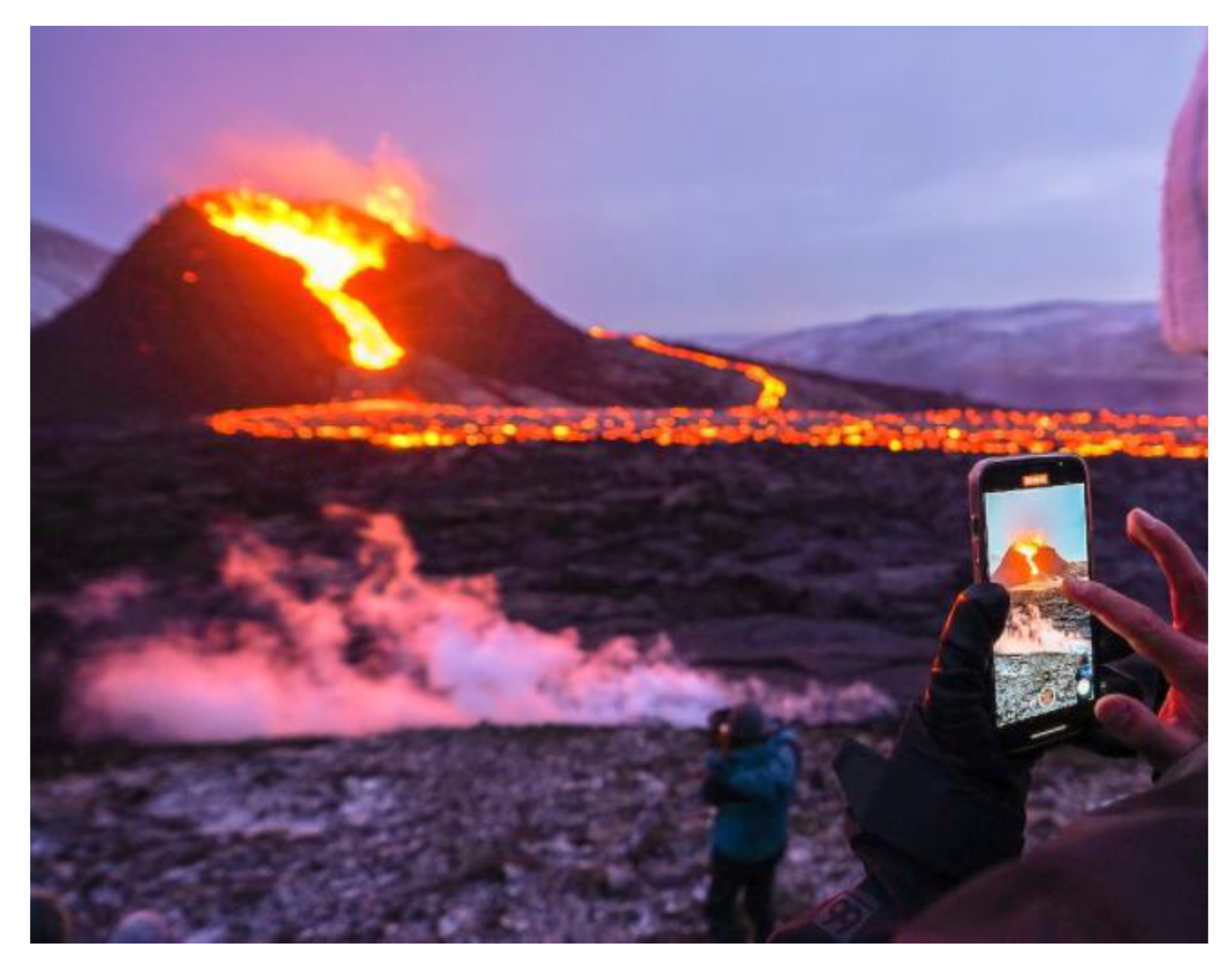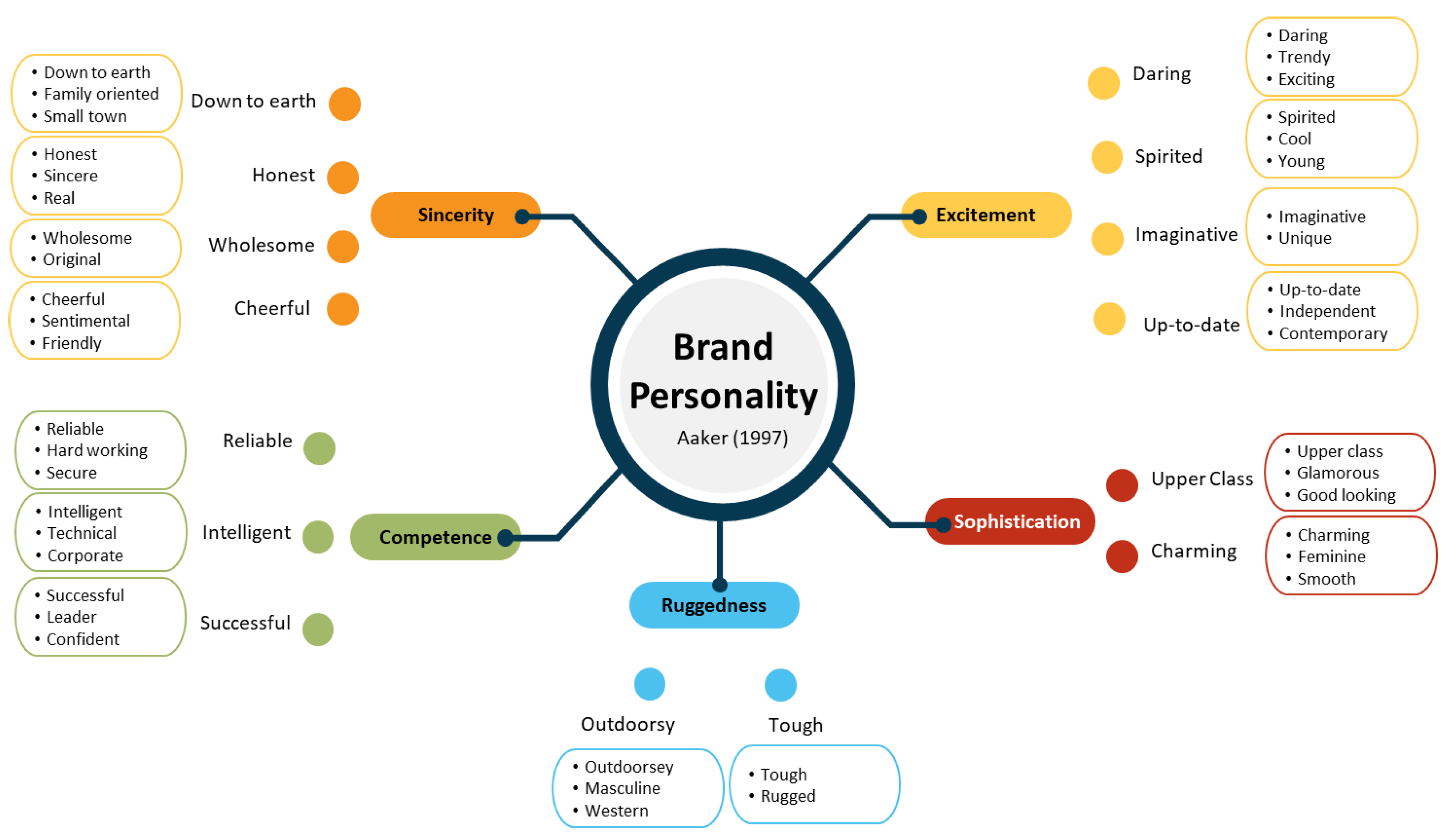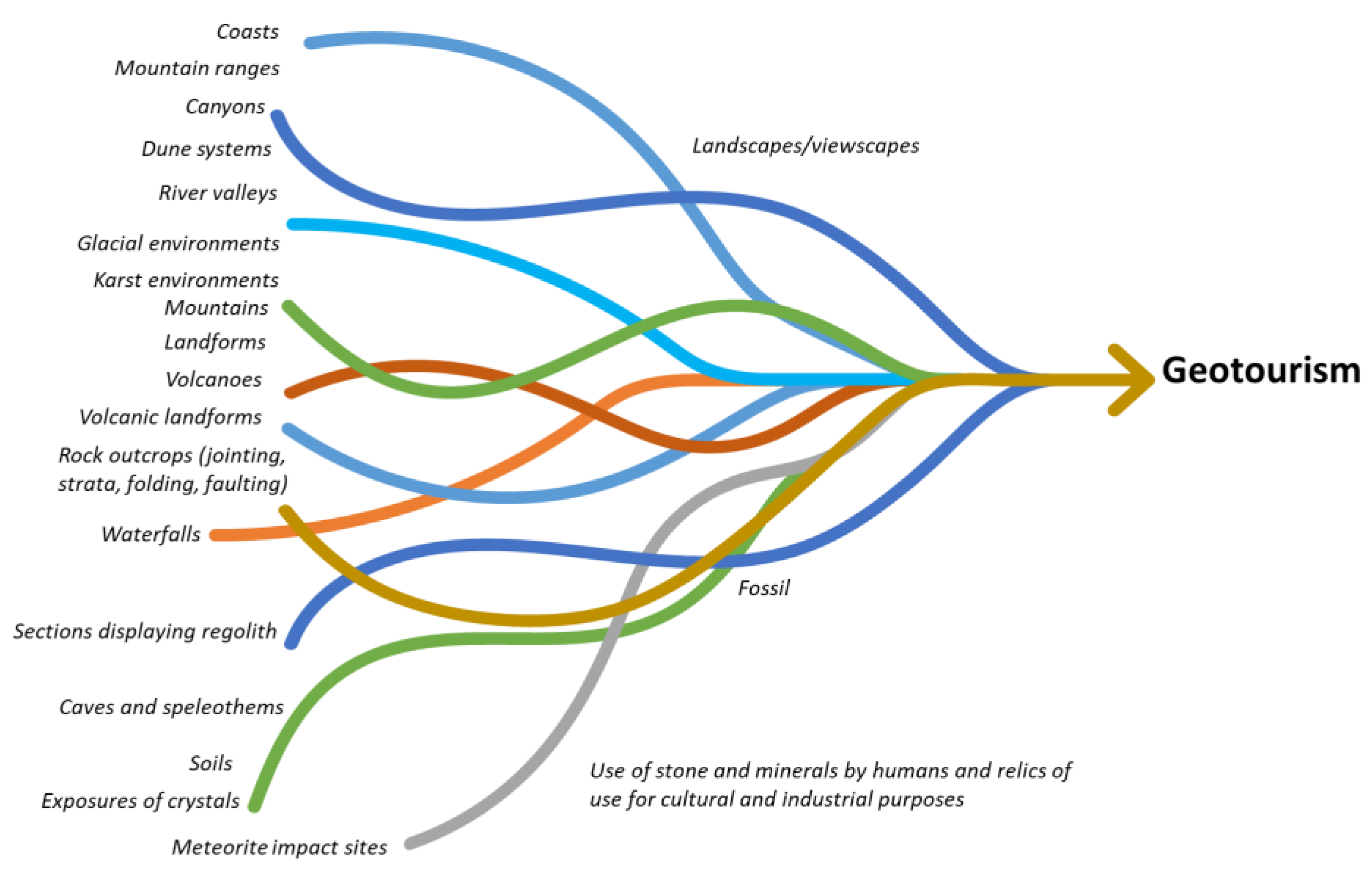Geotourism was first defined in 1995 by Thomas Hose under the strict perspective of “geological tourism” and has since undergone several changes. Nowadays, tourists are considered an opportunity to receive aesthetic impressions and knowledge about the local geosystem. Geotourism is a sub-niche of nature tourism characterized by being environmentally innovative and focusing specifically on landscape and geology
[1]. According to Dowling and Newsome
[2], geotourism has expanded to encompass several attributes—geology, tourism, geosites, visits, and interpretation—and needs to be considered not as a type of nature tourism but as an approach to nature
[2] and sustainable tourism
[3].
Figure 1. Scope and focus of geotourism. Source: Adapted from Newsome, Dowling, and Leung
[4].
However, as pointed out by Mikhailenko, Nazarenko, Ruban,
and Zayats
[5], tourists’ interest in geotourism experiences does not rely only upon “purely geological facts.” In addition to the classification scheme proposed by Newsome, Dowling, and Leung
[4], the aesthetic properties of the geosite need to be acknowledged
[5]. These authors proposed a geological structures aesthetics-based classification system that reflects tourists’ perception and image description and establishes a more understandable format to appreciate a geosite’s heritage.
Figure 1 presents different types of geoattractions. Similar to the roots of a tree that connect to the ground and support the tree, the unique combinations of other landscape elements and their integration create the uniqueness of the geotourism destination. There are no two equal geosites, even when rooted in the same type of landscape, becoming an attraction to tourists.
The distinctive landscape elements and geological formations of geoattractions provide an experience that is richer than the sum of its parts
[1], pleasing visitors with varied interests, especially tourists coined as belonging to geological tourist tribes
[6]. Additionally, geotourism involves the community; local businesses and civic groups promote and provide distinctive and authentic experiences to tourists
[1].
The number of geological tourists exploring volcanic and geothermal resources increases
[7], reflecting spaces becoming accessible, public visibility, and the emergence of a new adventure tourism segment, “the lava seekers”. In the last two decades, volcanoes have been explored as tourism attractions in many destinations, ensuring tourism development while promoting the conservation and protection of geoheritage. Iceland and Hawaii are well-known destinations that have developed a wide range of activities surrounding active and non-active volcanoes
[8]. The volcano activity that started in Canary Island in September 2021 will change the local landscapes and the tourism experiences offered. A news article in National Geographic (2021) noted that even during a pandemic, “thousands of people in Iceland hiked into the Geldingadalur valley to watch fiery lava splatter and spill from the crater of the Fagradalsfjall volcano after it erupted for the first time in nearly 800 years.”.
Regardless of its popularity, volcano tourism is still an under-researched field of study within tourism
[9]. The earliest research works tend to focus on volcanic attributes and their value for those planning the destination offer
[9][10]. Other studies have focused on risk assessment and natural hazards (Heggie, 2009), and more recent attention has centered on tourists’ motivations, satisfaction, and risk perception concerning volcanic activities
[11][12][13][14].
Volcanic and geothermal tourism are an essential part of geotourism
[8] as well as sustainable tourism. This geotourism subcomponent explores the geodiversity and geological heritage of a particular destination. More specifically, there are attractions related to active volcanoes and geothermal environments
[15]. This form of tourism is quite rich and adaptable because it combines the traits of adventure tourism and passive tourism, allowing tourists to choose their level of involvement in volcano-driven activities.
As in other environmentally innovative forms of tourism, the whole geotourism sphere of perception should produce an experience that appeals to the tourists’ five senses
[16][17]. Volcanic areas are the most appropriate for meeting these requirements:
- (a) Vision—volcanic areas are not just static landscapes; they also have live movement, depending on whether the volcano is active (see Figure 2).
- (b) Hearing—tourists can listen to volcanic activity (such as eruptions), geysers, or sounds produced by hydrothermal activity.
- (c) Taste—tourists can explore taste in exceptional and punctual cases (such as in the Azores and Hawaii, where tourists can taste the food cooked underground. The method consists of digging a hole where food is deposited and slow-cooked, exploiting volcanic activity to steam cook food).
- (d) Smell—tourists can experience the odorous gases that often accompany volcanic activity.
- (e) Touch—tourists can not only touch volcanic rocks to obtain tactile sensory experiences but can also experience high soil temperatures in geothermal areas.

2. Motivation Factors in Volcanic Tourism
The motivations impelling tourists to seek out volcanoes are broader than the five-sense experience
[11]. As in other nature-driven tourism experiences, tourists are invited to submerge into a close relationship with nature, contemplating Mother Nature’s show. However, this rewarding contact can come with a range of hazards
[18].
In most geothermal areas, hot spring formations do not require magma to reach high temperatures. Instead, as water passes through underground rocks, the geothermal temperature gradient combined with time and the intense pressure of the earth forms thermal springs rich in minerals and metallic elements. The effect of heated rocks under the surface can cause several processes, some of which manifest as geothermal phenomena such as thermal springs, fumaroles, geysers, boiling lakes, heated steam currents, and boiling mud puddles
[19].
It is increasingly common to see adventure-driven tourists visit volcanic sites
[20][21] as they search for active, dormant, or extinct volcanos. Nonetheless, active volcanoes and geothermal areas have risks and hazards associated with volcanic eruptions and other volcanic-nature manifestations that must be considered
[22]. Erfurt-Cooper
[23] posits that some risks can be mitigated through a suitable communication process and the adoption of preparedness measures.
Aquino and Schänzel
[14] noted the existence of different pull and push factors in volcanic tourism. Two pull factors are associated with disasters and cultural heritage, driven by volcanic and geological attributes. In comparison, four push factors are related to severe leisure attributes: relaxation and escape, novelty-seeking, volcano knowledge-seeking, and socialization. The authors found different motivation patterns between domestic and foreign tourists. The former value escape, relaxation, and socialization motives, while the latter value novelty and focus on the experience of visiting a volcano. These findings are helpful for destinations that want to develop and market volcano-based geotourism. Despite tourists’ motives and interests, destinations face relentless competition
[24], which impels DMOs to search for the points of parity and difference that enhance destinations’ attractiveness from the tourist’s viewpoint.
Such points of parity and difference emerge from the destination experience, which can encompass the impressions, ideas, and beliefs formed in one’s mind during travel
[25][26]. Ren and Blichfeldt
[27] argue that “One clear identity! One clear image!” is the key to successful destination branding. However, we must acknowledge that what the DMOs communicate is a brand identity that, when absorbed by tourists, becomes the destination’s image. Kislali and Kavaratzis
[26] noted that technology had enhanced the number of information sources regarding destinations, leading to a more complex and richer image-formation process.
For someone who has not yet visited a particular volcano tourism destination, the destination’s image is created by combining different sources of information
[28], such as media content, intermediaries, visitors, and other tourism and hospitality agents
[29][30]. Additionally, the possibility of interacting with websites with multimedia and social networking capabilities allows tourists to “experience” destinations, without having to visit them physically
[31][32].
Clear destination identities are expected to make tourists compose clear destination images so that they start dreaming of visiting the destination
[33]. As a result, volcano tourism destinations need to establish a congruent and aligned online presence that supports precise image formation.
Chung and Lee
[34] demonstrated that the quality of information on DMOs’ (Destination Marketing Organizations) webpages indirectly affects tourists’ intentions to visit a particular destination. The images presented by the content on the DMOs’ webpages are often different from those presented by other online sources (for example, the websites of tour operators and travel agencies, online travel communities, online travel magazines, and travel blogs
[35][36].
For some, the destination image can be seen as a subset of a broader field that uses the image measurement. It comprises information created and shared related to specific features or attributes that overcome the holistic impressions
[28]. Therefore, several authors’ studies have illustrated and analyzed destination images
[37].
Destination image, projected by the destination stakeholders and co-created by tourists, is considered a determinant since it reflects and allows a better understanding of travel behavior. In contrast, it allows designing effective marketing and communication strategies.
The relevance of this topic is evident, with studies spread over several disciplines other than tourism, ranging from psychology and environmental planning to marketing and geography.
This image formation occurs as a mental process, where impressions are chosen from different information sources and integrated as a solo perception that can evolve. Therefore, developing methodologies that allow a comprehensive and accurate measurement of the destination image is necessary.
Over time, authors have adopted different approaches around two main concepts: image functional and psychological components and holistic image. The functional components are considered to be all features or elements directly observable or measurable, while the psychological characteristics are related to psychological states that cannot be directly measured. For example, in geotourism or volcanic tourism, the functional components are linked to the geodiversity observed and acknowledged, whereas the psychological is related to feelings promoted by the experience.
The destination’s overall impressions can be achieved when combining this state of mind with the holistic image of the destination. The brand personality model, developed by Aaker
[38], is quite suitable to measure a destination’s holistic image
[39].
The model groups brand personalities into five broad categories, subdivided into personality traits and strengths, provided by several adjectives linked to each dimension (see Figure 3).

Figure 3. Brand personality model. Source: Adapted from Aaker
[38].
This model has been widely applied to destinations
[39][40][41][42][43][44]. The sincerity trait is associated with destinations that provide a transparent experience and use real-life experiences, along with the facts, to promote itself and what it offers. The excitement trait is linked to destinations that provide tourists with an unforgettable experience since they encourage them to experience a journey of discoveries, creating much hype around the experience. The competence trait reflects the destination’s commitment to quality. Destinations that present a sophistication trait combine luxury and superiority offers. Finally, the ruggedness trait is associate with destinations that focus on an outdoorsy and nature-centered experience. Thus, a destination brand personality that positively resonates with tourists will have the edge over competitor’s destinations
[44].
Therefore, destination-image formation is not simple. It includes the brand identity created by the DMO and the tourists’ own image-formation process, integrating DMO-projected identity with other sources of image creation (peers and firms) in an ongoing brand image co-creation
[29].



